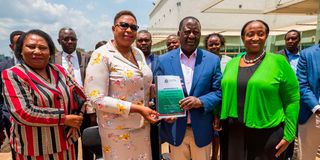Will MPs finally end the gender rule impasse?

Gender CS Aisha Jumwa hands the report on the two-thirds gender rule to Azimio leader Raila Odinga at Capitol Hill Square, Nairobi, on February 27, 2024. Looking on are members of the Multi-Sectoral Working Group on the Two Third Gender Principle.
What you need to know:
- The taskforce on the two-thirds gender principle was received with gusto by Gender and Affirmative Action CS Aisha Jumwa, last Friday.
- The taskforce has recommended amendments to the Constitution, the Elections Acts and the Political Parties Act.
- That is the easy part; the more difficult one is the realisation of the same.
The report by the taskforce on the two-thirds gender principle in the legislature was received with gusto by the Cabinet Secretary for Public Service, Gender and Affirmative Action, Aisha Jumwa, last Friday.
This principle is based on Article 27 of the Constitution, which states that “the electoral system shall comply with the principle that not more than two-thirds of the members of elective public bodies shall be of the same gender.”
The taskforce has recommended amendments to the Constitution, the Elections Acts and the Political Parties Act. That is the easy part. The more difficult one is the realisation of the same. It is in this regard that it is necessary to trace the journey in trying to get this principle enacted.
The first legislative attempt on this principle was mooted by Mutula Kilonzo (deceased) through the Constitution of Kenya Amendment Bill (2011), which recommended post-election nomination of women in such numbers as to meet the threshold.
The bill lapsed before debate, hence died a natural death.
In 2012, the Attorney General sought a Supreme Court advisory on whether the principle should be implemented in the 2013 General Election.
The advisory prescribed that such legislation be in place by August 27, 2015.
Based on this, a technical working group was formed in 2014 to work out an implementation formula.
The group considered various formulas and recommended a constitutional amendment to ensure post-election inclusion.
In 2014, Mwingi Central member of Parliament Joe Mutambo introduced what was essentially a mischievous bill seeking to relieve the National Assembly of the responsibility to pass the legislation.
It also proposed other radical measures that would reduce the size of Parliament.
The bill was defeated and so the journey continued.
The next effort was through a bill moved by Aden Duale in 2015 to increase the number of special seats after elections and eliminate party nominees. The bill was defeated, hence the deadline given by the Supreme Court passed.
The defeat resulted from lack of quorum. Interestingly, the same Parliament that could not raise a quorum for voting on it was able to do so to extend the deadline for enactment, betraying distaste for the principle.
The exact bill was reintroduced in the Senate by Judy Sijeny but met the same fate.
Progressive realisation
Next was a bill by Samuel Chepkong’a in 2015. This bill proposed progressive realisation of the two-thirds gender principle.
It was roundly rejected by women parliamentarians who detested the fact that it did not provide a definite timeframe within which the required numbers should be realised. They regarded it as a delaying tactic.
The closest the constitutional amendment bill came to being passed was in 2016 when it was voted for twice after the intervention of the speaker.
The first vote attracted 195 supporters, 38 short of the 233 required for a constitutional amendment.
On the second vote, it got 159, much lower than before, displaying a sense of fatigue from lawmakers.
There were two primary reasons for the debacle. One, women did not have the necessary numbers on their own to get the bills passed and desperately needed the support of male colleagues.
Two, many male legislators just did not believe that women should join Parliament through affirmation.
They considered affirmative action as undemocratic and variously pointed out that there was no value added by the county women representatives.
The hostility was clear in their reaction to an advocacy message by the Federation of Women Lawyers indicating to them that it would be watching how they voted. This was interpreted to be an attempt to blackmail Parliament and it backfired.
Duale introduced another bill in 2018, again seeking post-election top-up mechanisms to bring the number of the lesser group to the threshold required. He also proposed deferment of implementation until after the 2022 elections.
This bill also died because there was palpable evidence that there would be no quorum to pass it as the voting date of November 28, 2018, loomed.
While the quest for increased women’s numbers in the legislature continues, it must be pointed out that the framers of the Constitution themselves abdicated responsibility by not making the two-thirds principle a self-executing provision, the same way it is with county assemblies, where if any gender does not meet the threshold, then post-election nominations are done to fill the gap.
Also read: The long walk to the two-thirds gender rule
This has worked although it implies that the size of an assembly is elastic, unpredictable and could be financially draining in what is technically called the gender penalty.
The proposals by the taskforce will still depend on the action of parliamentarians. Will Parliament accept the proposed amendments? We wait to see.
The writer is an international gender and development consultant and scholar ([email protected]).





